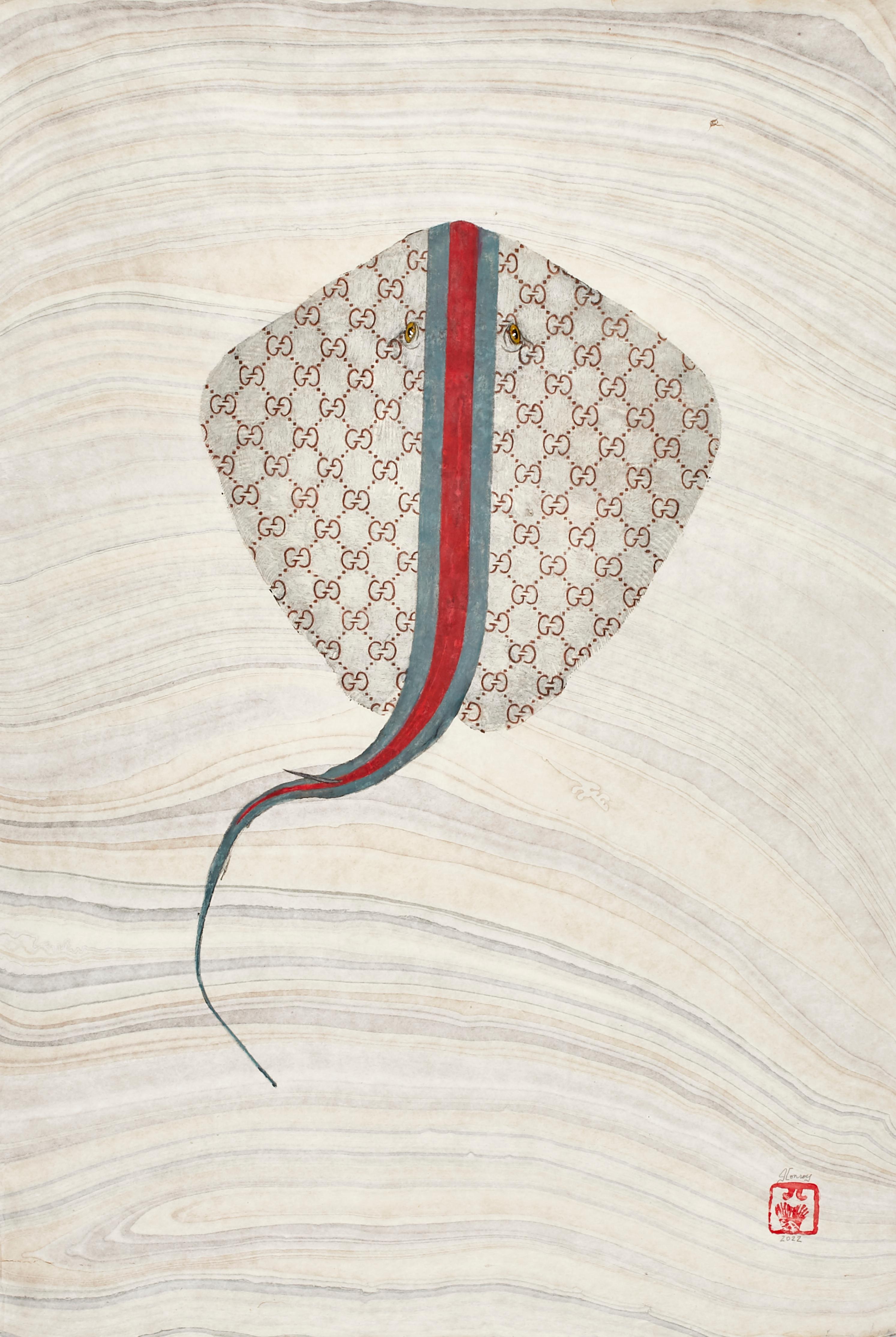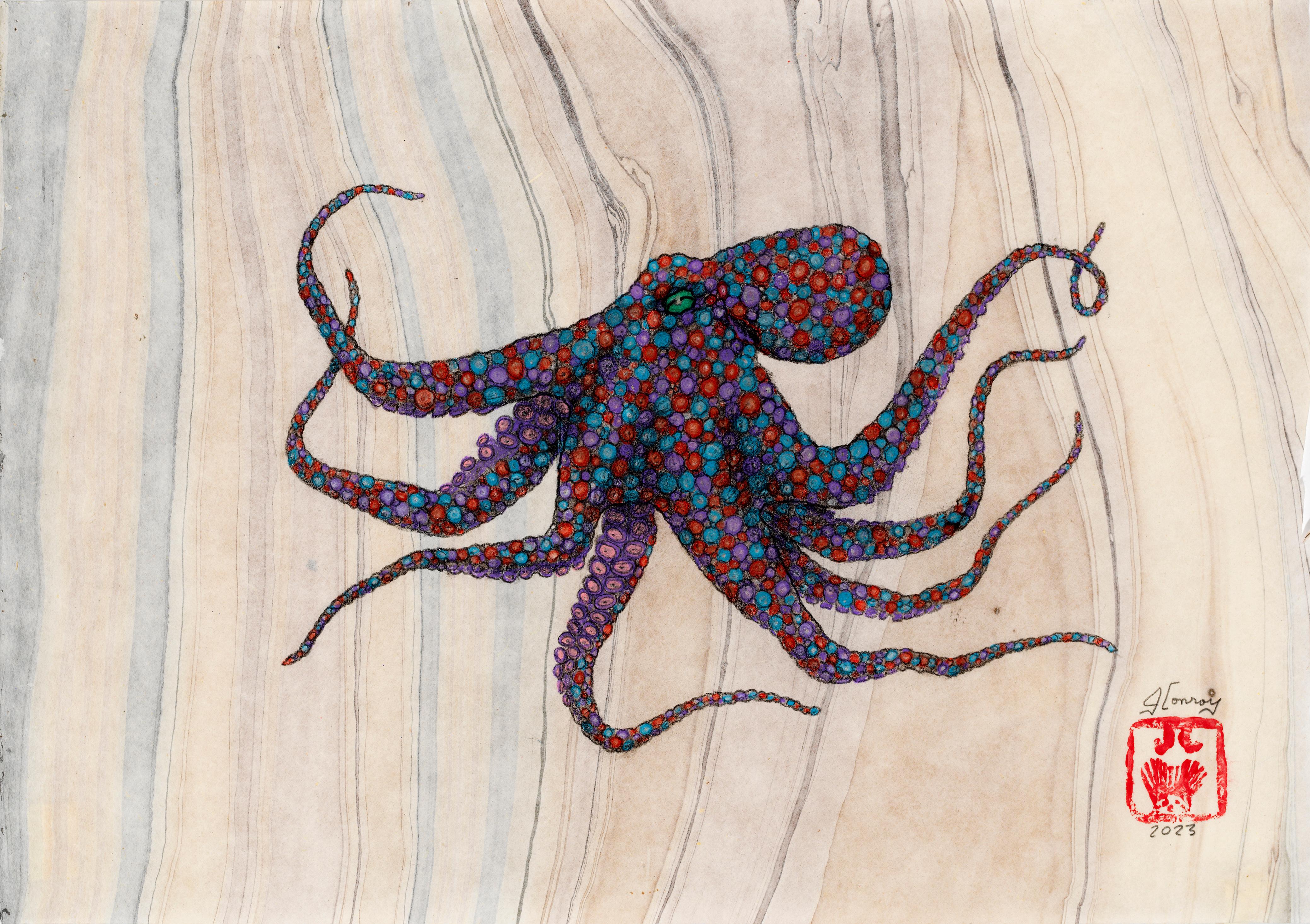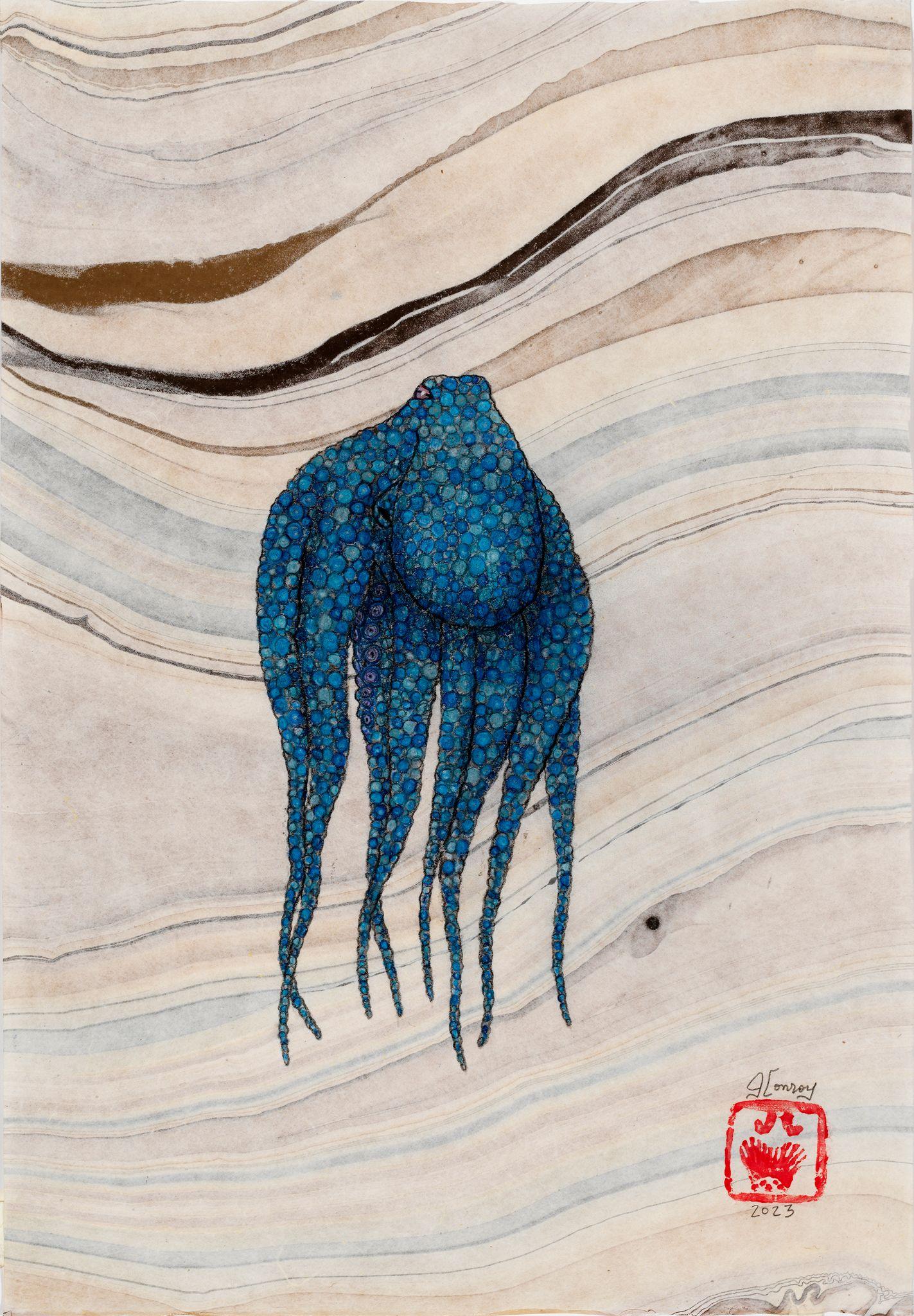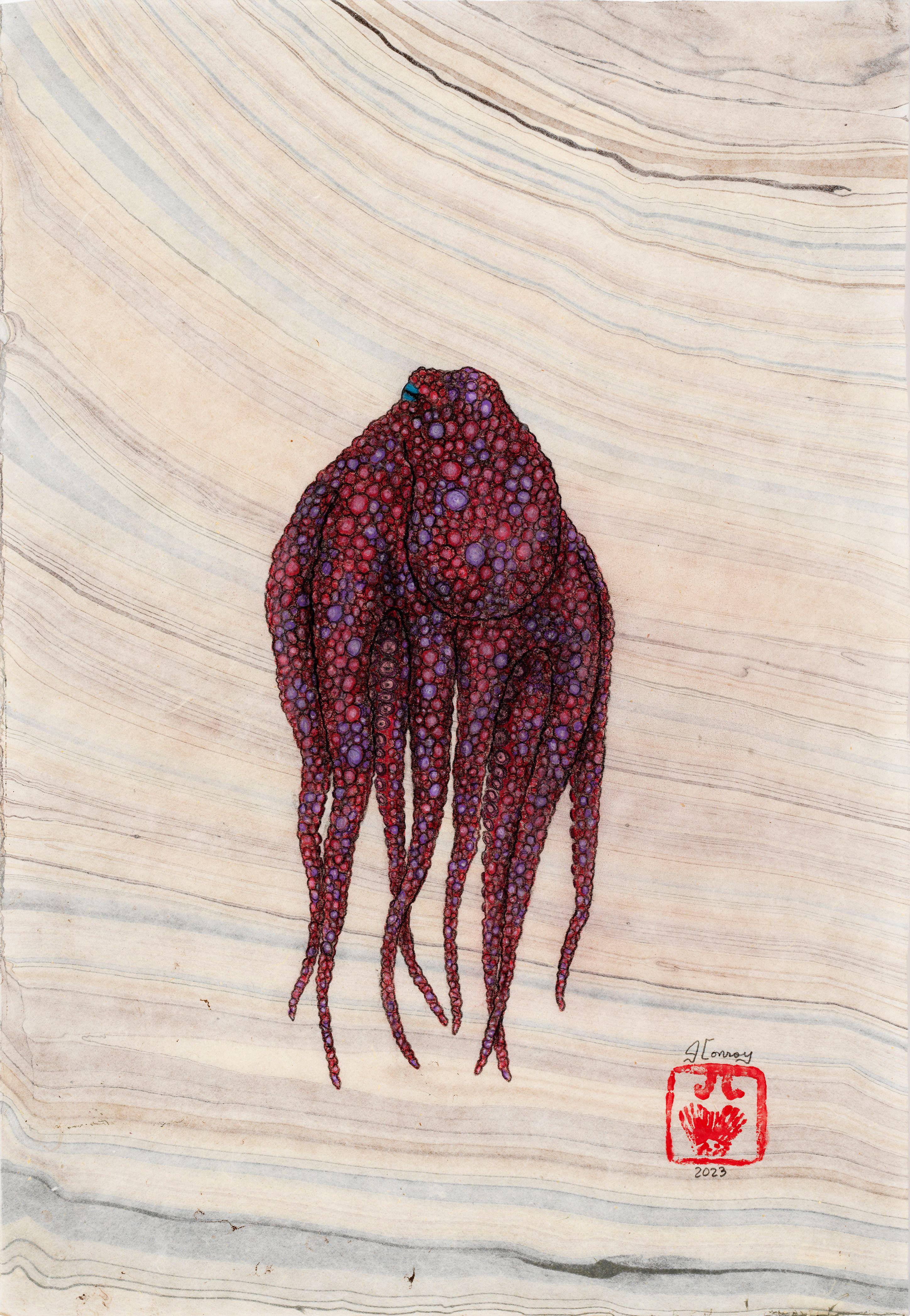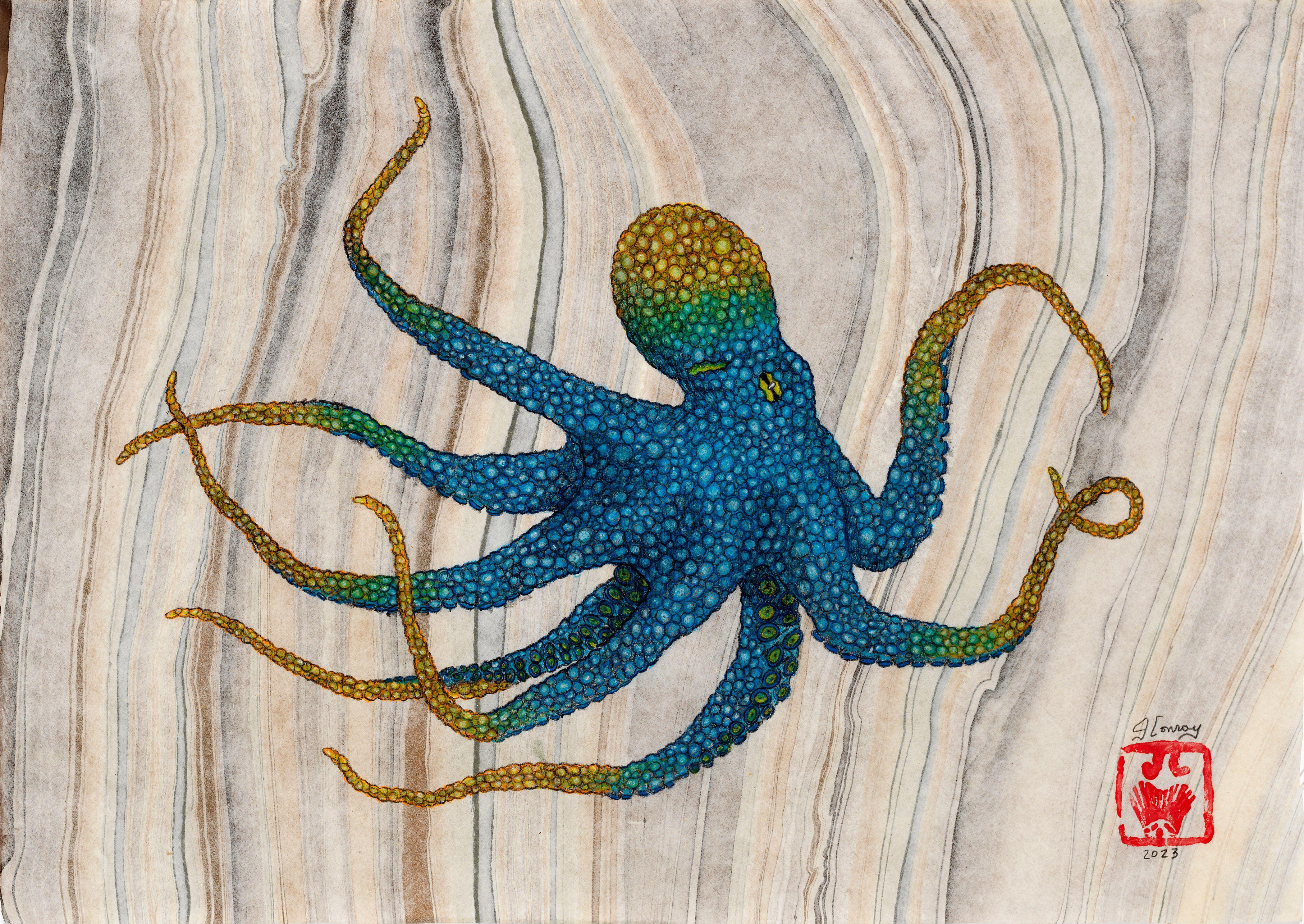Items Similar to “The Bird”
Want more images or videos?
Request additional images or videos from the seller
1 of 5
Nahum Tschacbasov“The Bird”1961
1961
About the Item
Post Modern experimental artwork of watercolor on handmade paper by the well known Russian/American artist, Nahum Tschacbasov. Signed lower left and dated 1961. Condition is very good. Provenance: Estate of the artist, Nahum Tschacbasov. Framed floating on cream mat board in a contemporary decorative frame. Overall measurements are 14.25 by 14.25 inches.
Russian-American artist Nahum Tschacbasov (1899-1984) is known for his cubo-surrealistic works which feature a strong psychological element. Some of his work bears a resemblance to work of another Russian-American artist--David Burliuk. He was somewhat of a late starter, moving to Paris in 1932 to study under Adolph Gottlieb, Marcel Gromaire and Fernand Leger. He had his first exhibition in Paris in 1934. He then returned to the US where he joined Rothko and Gottlieb at the Galery Seccession. He was one of the co-founders of The Ten, a group of social conscious abstract painters which included Rothko, Gottlieb, Joseph Solman and Ilya Bolotowsky, among others.
In 1944, he began to work at Stanley Hayter's Atelier 17, a center for surrealistic ideas. Between 1936 and 1943, he had five one-man exhibitions at the ACA Galleries and participated in five group shows. He also exhibited at the Whitney, the Pennsylvania Academy of Fine Arts, the Knox Albright Museum, the Chicago Institute of Fine Art and Corcoran, among others. His work can be found in the permanent collections of the Met, the Whitney, the Brooklyn Museum and the Jewish Museum.
Tschacbasov has been the subject of two recent retrospective at Fletcher Gallery, Woodstock, NY and in my own gallery, Arthur T. Kalaher Fine Art in Southampton, NY. He was also the subject of a retrospective at the National Arts Club entitled: "Nahum Tschacbasov: A Retrospective" in 2013.
- Creator:Nahum Tschacbasov (1899-1984, American)
- Creation Year:1961
- Dimensions:Height: 9.25 in (23.5 cm)Width: 9.75 in (24.77 cm)Depth: 0.1 in (2.54 mm)
- Medium:
- Movement & Style:
- Period:
- Condition:
- Gallery Location:Southampton, NY
- Reference Number:1stDibs: LU1417292912
About the Seller
4.9
Platinum Seller
These expertly vetted sellers are 1stDibs' most experienced sellers and are rated highest by our customers.
Established in 1977
1stDibs seller since 2013
464 sales on 1stDibs
Typical response time: 1 hour
- ShippingRetrieving quote...Ships From: Sarasota, FL
- Return PolicyA return for this item may be initiated within 7 days of delivery.
More From This SellerView All
- “The Crow”Located in Southampton, NYOriginal gouache and watercolor on brown archival paper of a standing crow in profile. Signed and dated lower right. Condition is good to very good. Colors of the bird are strong a...Category
1920s Modern Drawings and Watercolor Paintings
MaterialsGouache, Archival Paper, Graphite
- “Cat in Profile”Located in Southampton, NYExquisitely done profile of a cat done with graphite, watercolor and brushed wash by the Norwegian born artist, Charles Hermansen. Signed lower middle. Circa 1940. Condition is very...Category
1940s Realist Animal Drawings and Watercolors
MaterialsWatercolor, Archival Paper, Graphite
- “Tiger”Located in Southampton, NYOriginal colored pencil on archival paper of a tiger in a jungle setting attributed to H.A. Wilson. No visible signature. Not examined out of frame. No current information on the art...Category
1980s Contemporary Animal Drawings and Watercolors
MaterialsArchival Paper, Color Pencil
- “Shore Sentry”By Syd SolomonLocated in Southampton, NYShore Sentry, is an original color, limited edition lithograph on handmade German black etching paper; printed by Topaz Editions in 1977. Artist proofs 10. Edition size 100. Provenance:: A Sarasota, Florida collector Signed: Artist signed lower left with edition size Image size: 22 by 30 inches Sheet size: 30 by 38 inches Edition 38/100 Condition: Excellent Overall framed size: 30.25 by 38.25 inches Framed under plexiglass in chrome colored metal gallery frame SYD SOLOMON BIOGRAPHY Written by Dr. Lisa Peters/Berry Campbell Gallery “Here, in simple English, is what Syd Solomon does: He meditates. He connects his hand and paintbrush to the deeper, quieter, more mysterious parts of his mind- and he paints pictures of what he sees and feels down there.” --Kurt Vonnegut Jr. from Palm Sunday, 1981 Syd Solomon was born near Uniontown, Pennsylvania, in 1917. He began painting in high school in Wilkes-Barre, where he was also a star football player. After high school, he worked in advertising and took classes at the Art Institute of Chicago. Before the attack on Pearl Harbor, he joined the war effort and was assigned to the First Camouflage Battalion, the 924th Engineer Aviation Regiment of the US Army. He used his artistic skills to create camouflage instruction manuals utilized throughout the Army. He married Ann Francine Cohen in late 1941. Soon thereafter, in early 1942, the couple moved to Fort Ord in California where he was sent to camouflage the coast to protect it from possible aerial bombings. Sent overseas in 1943, Solomon did aerial reconnaissance over Holland. Solomon was sent to Normandy early in the invasion where his camouflage designs provided protective concealment for the transport of supplies for men who had broken through the enemy line. Solomon was considered one of the best camoufleurs in the Army, receiving among other commendations, five bronze stars. Solomon often remarked that his camouflage experience during World War II influenced his ideas about abstract art. At the end of the War, he attended the École des Beaux-Arts in Paris. Because Solomon suffered frostbite during the Battle of the Bulge, he could not live in cold climates, so he and Annie chose to settle in Sarasota, Florida, after the War. Sarasota was home to the John and Mable Ringling Museum of Art, and soon Solomon became friends with Arthur Everett “Chick” Austin, Jr., the museum’s first Director. In the late 1940s, Solomon experimented with new synthetic media, the precursors to acrylic paints provided to him by chemist Guy Pascal, who was developing them. Victor D’Amico, the first Director of Education for the Museum of Modern Art, recognized Solomon as the first artist to use acrylic paint. His early experimentation with this medium as well as other media put him at the forefront of technical innovations in his generation. He was also one of the first artists to use aerosol sprays and combined them with resists, an innovation influenced by his camouflage experience. Solomon’s work began to be acknowledged nationally in 1952. He was included in American Watercolors, Drawings and Prints at the Metropolitan Museum of Art, New York. From 1952–1962, Solomon’s work was discovered by the cognoscenti of the art world, including the Museum of Modern Art Curators, Dorothy C. Miller and Peter Selz, and the Whitney Museum of American Art’s Director, John I. H. Baur. He had his first solo show in New York at the Associated American Artists Gallery in 1955 with “Chick” Austin, Jr. writing the essay for the exhibition. In the summer of 1955, the Solomons visited East Hampton, New York, for the first time at the invitation of fellow artist David Budd. There, Solomon met and befriended many of the artists of the New York School, including Jackson Pollock, Franz Kline, Willem de Kooning, James Brooks, Alfonso Ossorio, and Conrad Marca-Relli. By 1959, and for the next thirty-five years, the Solomons split the year between Sarasota (in the winter and spring) and the Hamptons (in the summer and fall). In 1959, Solomon began showing regularly in New York City at the Saidenberg Gallery with collector Joseph Hirshhorn buying three paintings from Solomon’s first show. At the same time, his works entered the collections of the Whitney Museum of American Art, the Solomon R. Guggenheim Museum, and the Wadsworth Athenaeum in Hartford, Connecticut, among others. Solomon also began showing at Signa Gallery in East Hampton and at the James David Gallery in Miami run by the renowned art dealer, Dorothy Blau. In 1961, the Guggenheim Museum’s H. H. Arnason bestowed to him the Silvermine Award at the 13th New England Annual. Additionally, Thomas Hess of ARTnews magazine chose Solomon as one of the ten outstanding painters of the year. At the suggestion of Alfred H. Barr, Jr., the Museum of Modern Art’s Director, the John and Mable Ringling Museum in Sarasota began its contemporary collection by purchasing Solomon’s painting, Silent World, 1961. Solomon became influential in the Hamptons and in Florida during the 1960s. In late 1964, he created the Institute of Fine Art at the New College in Sarasota. He is credited with bringing many nationally known artists to Florida to teach, including Larry Rivers, Philip Guston, James Brooks, and Conrad Marca-Relli. Later Jimmy Ernst, John Chamberlain, James Rosenquist, and Robert Rauschenberg settled near Solomon in Florida. In East Hampton, the Solomon home was the epicenter of artists and writers who spent time in the Hamptons, including Alfred Leslie, Jim Dine, Ibram Lassaw, Saul Bellow...Category
1970s Post-Modern Abstract Prints
MaterialsHandmade Paper, Lithograph
- Accabonac Harbor, East Hampton”Located in Southampton, NYOriginal watercolor on archival paper of Accabonac Harbor in East Hampton, Long Island by the regional artist Susan Deutscher. Signed lower left. Circa 1985. Condition is excellent. Professionally matted and framed in a thin natural birch wood frame. Overall framed measurements are 18 by 24...Category
1980s Post-Modern Landscape Drawings and Watercolors
MaterialsWatercolor, Archival Paper
- “Showgirl”Located in Southampton, NYHere for your consideration is a well executed mixed media painting composed of India ink and watercolor wash of a beautiful showgirl Signed lower left and dated 1980. Condition is excellent. Recently professionally re matted and housed in it original brass thin gallery frame. Overall framed measurements are 23 by 20 inches. Provenance: A Sarasota, Florida collector. As a child, growing up in the '30s and '40s, Earl Linderman was fascinated by the comic strips and Saturday matinees. He would spend countless hours drawing these characters, forming the foundation of his future as an artist of extraordinary imagination and execution. By the time he was in high school, Linderman was creating his own art, featuring heroes involved in adventurous dramas. Things have not changed much for the man who, since the early '70s, has been exciting art aficionados with his series, The True and Incredible Adventures of Doktor Thrill...Category
1980s Post-Modern Figurative Drawings and Watercolors
MaterialsInk, Watercolor, Archival Paper
You May Also Like
- Butterfly. 1968. Paper, watercolor, 76x55.5 cmLocated in Riga, LVAt the table. Paper, watercolor, 55x75 cm Malda Muižule was born in 1937 in the family of a blacksmith. Graduated from Liepaja Applied Arts High School (1957). She continued her stu...Category
1960s Post-Modern Animal Drawings and Watercolors
MaterialsPaper, Watercolor
- Gucci Ray - Sumi Ink on Mulberry Paper, Original Artwork, Gyotaku StyleBy Jeff ConroyLocated in Chicago, ILDesigners have an wide reach through out the world but have yet to reach the depths of the ocean. Artist Jeff Conroy has created this Gyotaku print of large ray entitled simply "Gucci Ray" to fill that void. To achieve this remarkable painting, the artist applies sumi ink to a sting ray he caught himself on Florida's Gulf Coast, then "prints" it onto Marbled Mulberry paper - a soft, handmade paper. He then embellishes the details with watercolor to give extraordinary dimension and interest to its overall aesthetic. The artwork is unframed. Please contact the gallery for framing options. Jeff Conroy Gucci Ray sumi ink and watercolor on mulberry paper 37h x 25w in 93.98h x 63.50w cm JEC088 Gyotaku - A Japanese word translated from "gyo" meaning fish and "taku" meaning stone impression and is believed to get its inspiration from Chinese stone rubbings of calligraphy, which then gave rise to printing . This tradition dates back to the mid-1800s and was used by fishermen to record their catches, but has also become an art form of its own. Prints were made using Sumi ink and Washi paper. It is rumored that Samurai would settle fishing competitions using Gyotaku prints. This original form of Gyotaku is still utilized today, and can be seen hanging in fish and tackle shops all...Category
21st Century and Contemporary Contemporary Animal Drawings and Watercolors
MaterialsWatercolor, Mulberry Paper, Sumi Ink
- Dippin' Dotopus - Gyotaku Style Sumi Ink Painting of a Multi-Colored OctopusBy Jeff ConroyLocated in Chicago, ILA small octopus is inked in the Japanese style of Gyo-Taku print making. Using sumi ink to "print" the octopus, the artist then embellishes it with colored pencil to convey an extra...Category
21st Century and Contemporary Contemporary Animal Drawings and Watercolors
MaterialsSumi Ink, Watercolor, Mulberry Paper, Color Pencil
- Fontainebleau - Gyotaku Style Sumi Ink Painting of a Multi-Colored OctopusBy Jeff ConroyLocated in Chicago, ILA small octopus is inked in the Japanese style of Gyo-Taku print making. Using sumi ink to "print" the octopus, the artist then embellishes it with colored pencil to convey an extraordinary dimensionality. By printing it on Mulberry paper, which mimics the swirl of water, the artist achieves a beautiful aesthetic. The artwork is unframed. Please contact the gallery for framing options. Jeff Conroy Fontainebleau sumi ink and colored pencil on mulberry paper 12.50h x 18.25w in 31.75h x 46.35w cm JEC120 Gyotaku - A Japanese word translated from "gyo" meaning fish and "taku" meaning stone impression and is believed to get its inspiration from Chinese stone rubbings...Category
21st Century and Contemporary Contemporary Animal Drawings and Watercolors
MaterialsSumi Ink, Watercolor, Mulberry Paper, Color Pencil
- Red Rum - Gyotaku Style Sumi Ink Painting of an OctopusBy Jeff ConroyLocated in Chicago, ILA small octopus is inked in the Japanese style of Gyo-Taku print making. Using sumi ink to "print" the octopus, the artist then embellishes it with colored p...Category
21st Century and Contemporary Contemporary Animal Drawings and Watercolors
MaterialsSumi Ink, Watercolor, Mulberry Paper, Color Pencil
- Cobalt Canary - Gyotaku Style Sumi Ink Painting of a Multi-Colored OctopusBy Jeff ConroyLocated in Chicago, ILA small octopus is inked in the Japanese style of Gyo-Taku print making. Using sumi ink to "print" the octopus, the artist then embellishes it with colored pencil to convey an extraordinary dimensionality. By printing it on Mulberry paper, which mimics the swirl of water, the artist achieves a beautiful aesthetic. The artwork is unframed. Please contact the gallery for framing options. Jeff Conroy Cobalt Canary sumi ink and colored pencil on mulberry paper 12.50h x 18.25w in 31.75h x 46.35w cm JEC122 Gyotaku - A Japanese word translated from "gyo" meaning fish and "taku" meaning stone impression and is believed to get its inspiration from Chinese stone rubbings...Category
21st Century and Contemporary Contemporary Animal Drawings and Watercolors
MaterialsSumi Ink, Watercolor, Mulberry Paper, Color Pencil
Recently Viewed
View AllMore Ways To Browse
Vintage Bird
Bird Vintage
Collection Birds
The Birds Of America
Bird Painters
Bird Artwork
Bird Man
Man And Bird
Vintage Bird Paper
Orange Birds
Group Of Bird Paintings
Vintage Bird Drawings
Vintage Drawings Of Birds
Retro Bird Drawings
Orange Bird Vintage
Pennsylvania Bird
Vintage Bird Artwork
Fernand Leger Drawing

